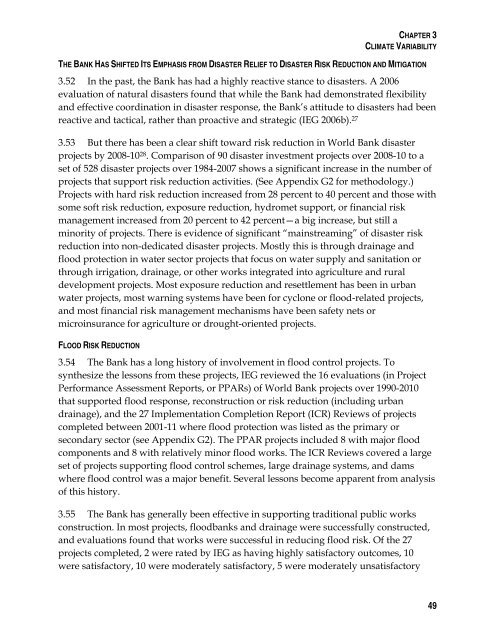Adapting to Climate Change: Assessing the World Bank Group ...
Adapting to Climate Change: Assessing the World Bank Group ...
Adapting to Climate Change: Assessing the World Bank Group ...
Create successful ePaper yourself
Turn your PDF publications into a flip-book with our unique Google optimized e-Paper software.
CHAPTER 3CLIMATE VARIABILITYTHE BANK HAS SHIFTED ITS EMPHASIS FROM DISASTER RELIEF TO DISASTER RISK REDUCTION AND MITIGATION3.52 In <strong>the</strong> past, <strong>the</strong> <strong>Bank</strong> has had a highly reactive stance <strong>to</strong> disasters. A 2006evaluation of natural disasters found that while <strong>the</strong> <strong>Bank</strong> had demonstrated flexibilityand effective coordination in disaster response, <strong>the</strong> <strong>Bank</strong>’s attitude <strong>to</strong> disasters had beenreactive and tactical, ra<strong>the</strong>r than proactive and strategic (IEG 2006b). 273.53 But <strong>the</strong>re has been a clear shift <strong>to</strong>ward risk reduction in <strong>World</strong> <strong>Bank</strong> disasterprojects by 2008-10 28 . Comparison of 90 disaster investment projects over 2008-10 <strong>to</strong> aset of 528 disaster projects over 1984-2007 shows a significant increase in <strong>the</strong> number ofprojects that support risk reduction activities. (See Appendix G2 for methodology.)Projects with hard risk reduction increased from 28 percent <strong>to</strong> 40 percent and those withsome soft risk reduction, exposure reduction, hydromet support, or financial riskmanagement increased from 20 percent <strong>to</strong> 42 percent—a big increase, but still aminority of projects. There is evidence of significant “mainstreaming” of disaster riskreduction in<strong>to</strong> non-dedicated disaster projects. Mostly this is through drainage andflood protection in water sec<strong>to</strong>r projects that focus on water supply and sanitation orthrough irrigation, drainage, or o<strong>the</strong>r works integrated in<strong>to</strong> agriculture and ruraldevelopment projects. Most exposure reduction and resettlement has been in urbanwater projects, most warning systems have been for cyclone or flood-related projects,and most financial risk management mechanisms have been safety nets ormicroinsurance for agriculture or drought-oriented projects.FLOOD RISK REDUCTION3.54 The <strong>Bank</strong> has a long his<strong>to</strong>ry of involvement in flood control projects. Tosyn<strong>the</strong>size <strong>the</strong> lessons from <strong>the</strong>se projects, IEG reviewed <strong>the</strong> 16 evaluations (in ProjectPerformance Assessment Reports, or PPARs) of <strong>World</strong> <strong>Bank</strong> projects over 1990-2010that supported flood response, reconstruction or risk reduction (including urbandrainage), and <strong>the</strong> 27 Implementation Completion Report (ICR) Reviews of projectscompleted between 2001-11 where flood protection was listed as <strong>the</strong> primary orsecondary sec<strong>to</strong>r (see Appendix G2). The PPAR projects included 8 with major floodcomponents and 8 with relatively minor flood works. The ICR Reviews covered a largeset of projects supporting flood control schemes, large drainage systems, and damswhere flood control was a major benefit. Several lessons become apparent from analysisof this his<strong>to</strong>ry.3.55 The <strong>Bank</strong> has generally been effective in supporting traditional public worksconstruction. In most projects, floodbanks and drainage were successfully constructed,and evaluations found that works were successful in reducing flood risk. Of <strong>the</strong> 27projects completed, 2 were rated by IEG as having highly satisfac<strong>to</strong>ry outcomes, 10were satisfac<strong>to</strong>ry, 10 were moderately satisfac<strong>to</strong>ry, 5 were moderately unsatisfac<strong>to</strong>ry49

















